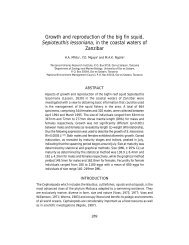gpa_east_africa_case.. - GRID Africa GeoPortal - UNEP
gpa_east_africa_case.. - GRID Africa GeoPortal - UNEP
gpa_east_africa_case.. - GRID Africa GeoPortal - UNEP
You also want an ePaper? Increase the reach of your titles
YUMPU automatically turns print PDFs into web optimized ePapers that Google loves.
activities but it is estimated to generate about 33% of the officially recorded Gross DomesticProduct. Earnings per worker are 2.6 times higher the minimum wages in the urban formalsector..Agriculture. Of the total area of DSM of 1,350km2, an area of 430km2 (or 32%) is taken upby urban development, 20km2 is forest land and 900km2 (or 67%) is rural only part of it inagricultural use. Agriculture is however the main activity within the region. Satellite imagepictures suggest that as much as 23% of the area of the region is used for agricultureproduction.Fishing. The total population of fishermen is disputed, estimates range from 3,000 - 50,000.This vast difference is explained by the small number of licensed fishermen relative to themuch larger number of non- registered fishermen. Despite the number of rivers crossing thecity and the few fresh water lakes and ponds, inland fisheries are limited. Offshore fisheriesare extensively exploited by small-scale fishermen trawling and netting the coastal waterslanding on average some 50,000 kg annually, marketed for more than TSh. 3.0 million.Estimated income. The average annual contribution of DSM region to the national GDP isreported at about 33% and the per capita income at about TSh. 197,000, both highercompared to other regions. The current average wage in DSM is $250. It is estimated that inthe informal sector earnings per worker are 2.6 times higher minimum wages, that is $650.Domestic wastewater services. DSM has no operative sewage collection infrastructure. Thesewerage system is old and degenerated. It covers an area of 130km of sewer, covers 15%of the households and consists of 11 networks supported by 17 pumping stations, includingthe City Center, parts of Sinza, Ubungo and Vingunguti. It was built in the late 1950's and itsattempted rehabilitated in the period 1980–1988 has been unsuccessful. Sewage from theareas supposed to be served is discharged into oxidation ponds and directed to the oceanuntreated. Poor managing of these ponds result in overflowing and spreading of sewer to thesurroundings. Only 4 of the 8 oxidation ponds are considered to be operating (University ofDar-es-Salaam, Kurasini, Mikocheni and Vingunguti). 80% of the households in the rest ofDSM use on-site pit latrines and septic tanks. High water table in various parts of the cityduring the short and long rains further compounds the poor sanitary conditions with many pitsoverflowing into the drainage system emptied manually, often by the families themselves andoccasionally by private companies at a cost.Industrial wastes. The rapid growth of informal sector activities generates industrial wastesin settlement areas and near rivers adjacent to coastal areas. Disposal methods areuncontrolled compounding the domestic wastewater loads reaching the settlements, riversand coastal areas. Car repair and washing activities are often near streams (e.g. Msimbaziriver along Jangwani, near Kilimanjaro Hotel etc) discharging dirty water covered with layersof oil. Within the city industries are concentrated mainly in the Mikocheni light industrial area,Nyerere road industrial area, Changombe industrial area, Morogoro Road industrial area,Mandela express industrial area and Mbezi along Ali Hassan Mwinyi road.• Msimbazi river has been found to be heavily polluted due to effluents from industriesalong Nyerere road industrial area (e.g. Vingunguti abattoir), Morogoro road (e.g.Tanzania-China Friendship Textile mill), Mandela road (e.g. Tradeco Ltd), TanzaniaBreweries Ltd. Dar es Salaam plant, leachate from Vingutinguti crude dump.• Karibu Textile Mill discharges its effluent to the Mzinga River.• Leachate from closed Kabuma crude dump (in Temeke) flowed into the ocean (nowclosed ).Table 2: Pollution load to surface water resources (kg/day)TypeIndustrialEffluent Pit latrines SepticWithoutfacilities TotaltanksBOD 28,330 15,282 3,275 9,897 56,784COD 29,904 16,131 3,457 10,447 49,776Suspended solids 47,216 25,470 5,458 16,495 78,429Final Draft Report – Cost Benefit Case StudiesGPA Strategic Action Plan on Sewage, October, 200029



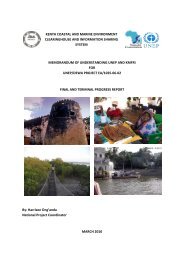
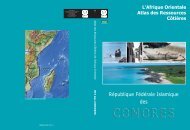
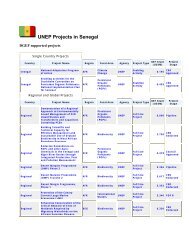

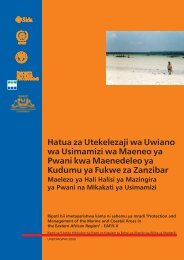
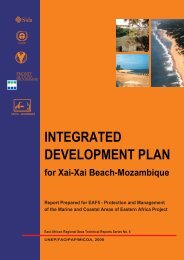
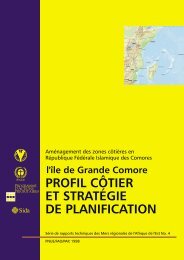
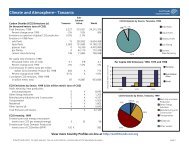

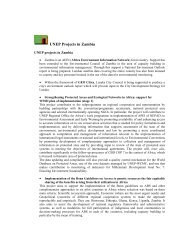
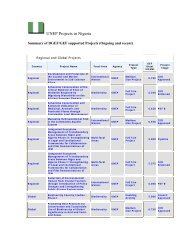
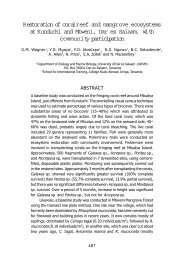
![Please Click to download [English] - GRID Africa GeoPortal - UNEP](https://img.yumpu.com/30633391/1/184x260/please-click-to-download-english-grid-africa-geoportal-unep.jpg?quality=85)
